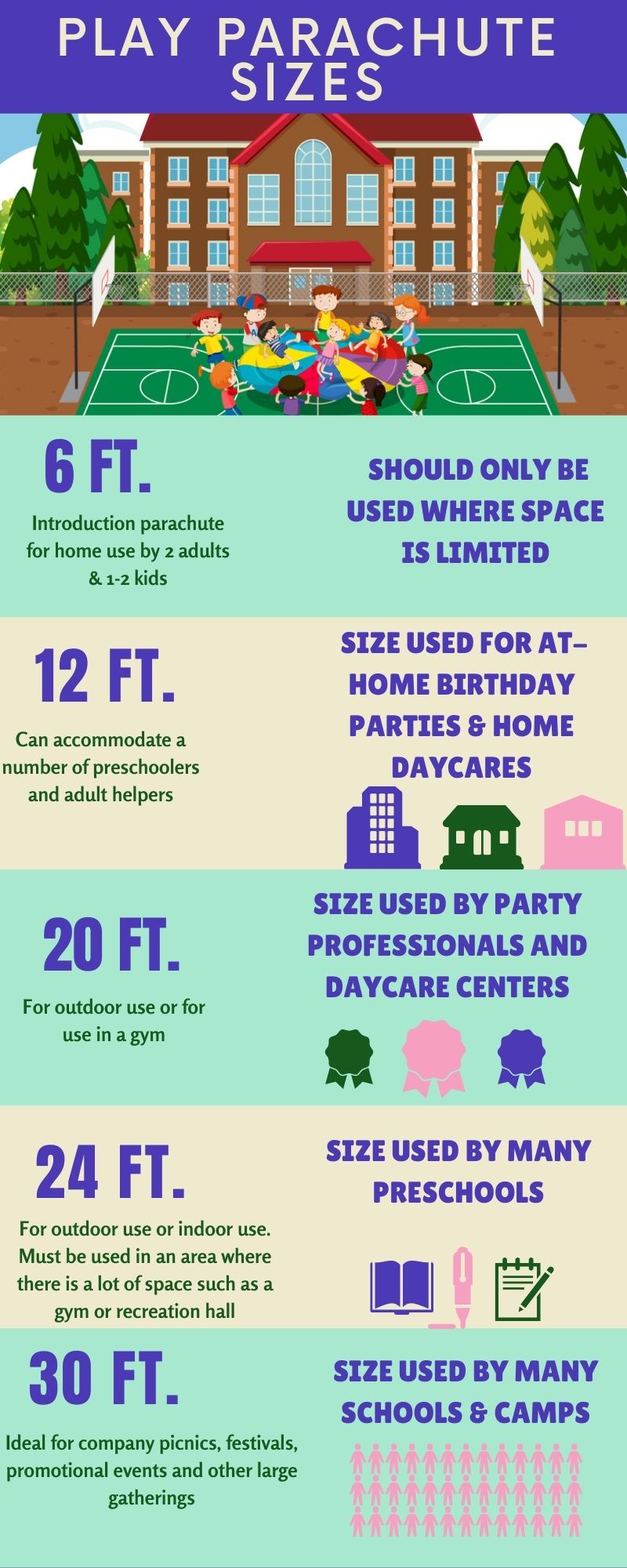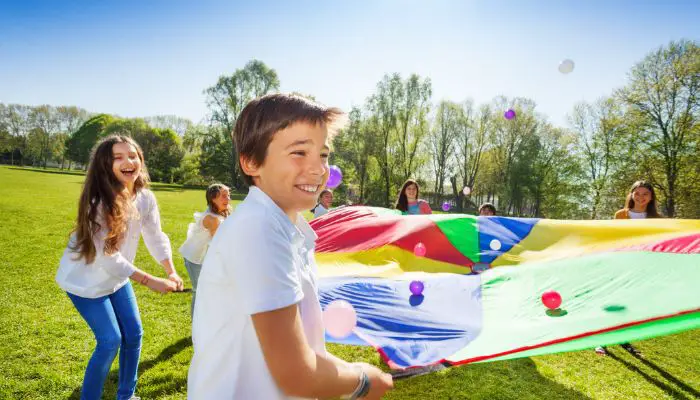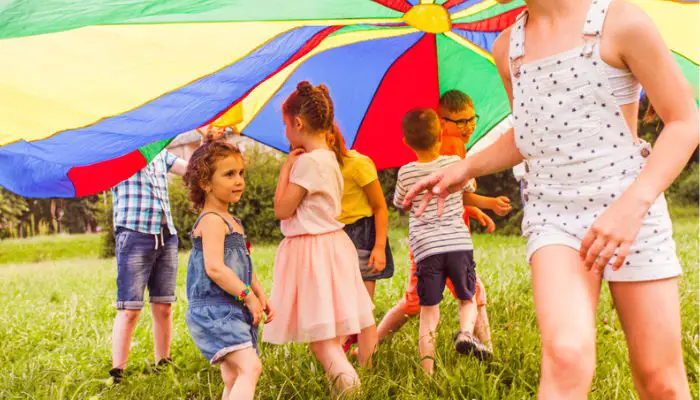48 Parachute Games Kindergarteners & Toddlers Will Love

We've rounded up 48 parachute games that are just perfect for kindergarteners and toddlers, turning any playtime into an adventure of colors, laughter, and teamwork.
These games are not only about having a blast (which, trust me, your kids totally will) but also about sneaking in those all-important lessons on cooperation, motor skills, and even a bit of creativity.
Ready, set...jump!
Kidding. Not that kind of parachute.

Exciting Parachute Games for Kids

1) Take My Place
Kids call each other’s names and exchange places. The player who responds last will be disqualified.
2) Treasure Hunt
Make the kids play a typical treasure hunt under the parachute. Prepare chits well in advance.
Remember, do not use complex words.
3) Mission Impossible
Kids try to make the neighboring player lose the grip of the parachute. Whoever is successful gets to take extra attempts.
Avoid playing this on concrete or other hard slippery surfaces, as a fall could cause serious injury.
4) Weatherman
Or, weatherwoman. One person is assigned this designation and made to stand in the center.
The parachute will be waved or moved as per the season or condition named.
5) Make a Goal
No goalpost or football field is required for the commencement of this fun game. A circle can be made in the center using a marker.
To further enhance the sportsmanship, cut out a hole so that the goal is made.
6) Popcorn
Place a number of bean bags, small balls, or cotton balls onto the parachute. Shake to make them pop up like “popcorn”.
Use a lot of colored balls and a giant parachute for this game.
Make sure you’re using a lightweight ball for Popcorn so that the kids do not end up hurting themselves. They should bounce the balls as much as possible.
7) I Big or You Big
Make two teams. Whichever team enlarges themselves, the circle with the most will be the winner. Do not allow any extra materials.
Use a parachute with stretchable material if possible.
8) Tomb
A large table fan is needed for this game. Make sure it is placed at such a location that the air flows under the parachute.
The kids’ objective is to raise the parachute as much as possible.
The final shape should resemble a tomb.
9) Quick See-Saw
The only difference is that the kids will make the see-saw. Two opposite ones will sit and stand alternatively, and the parachute will swirl accordingly.
10) Spot the Spot
Two kids will exchange places while the kid in the center is blindfolded. The former has to “spot” who has changed his or her “spot.”
If no one is recognized, the game will be repeated.
11) Parachute Rooms
The area under the parachute will be divided into four or five areas. A room name will be assigned to each of the areas.
The kids will choose which room they wish to enter and then act in accordance with the same environment.
12) Catch the Ball
One or more balls are bounced on the cloth, and the nearest toddler is supposed to catch it. If the ball drops on the ground, the expected catcher is disqualified.
As the game progresses, the number of balls can be reduced. They should be of different colors to enhance the recognition and scoring of the game.
13) Don’t Take the Ball
This is also referred to as “Cursed Ball.” This is the parachute version of passing the parcel.
The ball is passed by moving the parachute to and fro.
Both hands should be used to make this motion but touching the ball is not allowed. Make sure the ball is light enough to be moved from one area to the other.
14) Fruit Partners
Play this one in groups of two, named as a fruit. They move together to reach the other end.
If any other fruit can stop them, that particular child will take the game forward with their fruit partner.
This can be done systematically in alphabetical order. Try giving new names of fruits with pictures so that they can learn.
Elder children can be asked to spell out as well.
15) Swap Numbers
Each child is numbered according to position. They move in descending order in alternative rounds.
Whoever misses the counting is disqualified.
Other trends like even numbers, odd numbers, or prime numbers can be chosen.
16) Shake Hands
A lot of people consider this game to be an icebreaker as well. Two kids go under the play parachute and introduce themselves.
Then, they shake hands to invite the other two of their choice.
When all of them have introduced themselves, the next round can discuss hobbies or favorite food.
This game can be played for much longer time periods to ensure that all participants get a chance to introduce themselves.
17) Retrieve Your Shoe
On a beat, one child throws the shoe under the parachute.
The next child has to get it back before the time is over.
Keep the timer at thirty seconds for ease.
If one shoe is not retrieved on time, the subsequent child has to get back both of them, and so on.
If all the shoes are remaining, replay.
18) Merry-Go-Round
Songs are played, and this takes the form of a parachute-style ring-a-ring-a-roses. The kid who stops last will be asked to perform an act as soon as the music stops.
In case the act is not performed, that kid will be disqualified. Make sure there is no cheating.
19) Don’t Get Trapped
One child sits in the middle. On every wrong answer, the parachute falls and traps.
The child qualifies for the next round if more than five correct answers are given. Riddles in the form of questions can make this game even more entertaining.
A scorekeeper is a must for the swift progress of this game.
20) Alligator, Alligator
Kids lie down on their stomachs and crawl underneath to clear the distance. Do not touch the surface to ensure optimum speed.
Animal names like alligator or other terms like “Crawler kid” can be duly assigned.
The winner is the one who clears the distance in the minimum time.
21) Beach Ball Off the Ground
They are supposed to keep the beach ball afloat on the parachute with mutual understanding and cooperation.
As soon as it nears one of the edges, the nearest kid needs to direct it toward the center, or else they lose the game.
22) Fleas Off the Parachute
Small objects are placed under the parachute, and one child places them atop them. Others have to prevent this.
They can negotiate by offering exchange in place. Whoever collects the maximum number of objects is declared to be the winner.
23) Parachute Turtle
The parachute is in the shape of a turtle’s shell, and kids are required to maintain the shape. In case a kid fails to do so, they will have to stay in the shape of a turtle shell underneath the parachute.
Make sure the parachute size is large enough to accommodate all the children!
24) Put Teddy in a Swirl
A soft toy is kept between two kids. These two kids then move together around the parachute.
In case the toy falls, whoever picks it first will get it.
Others move in a circular motion while the three main players take the game forward.
25) Watch Your Tail
One child stands in the middle below the parachute, and others need to avoid being touched by him or her. The one in the middle is the “hunter,” while all others are named “prey.”
The hunter kid can be blindfolded for more fun and enthusiasm.
26) Shake Up the Fruit Salad
A fruit ball is prepared, and the colors match the bright colors of the parachute. The one chosen is taken to be the attacking site for kids.
Two people given the name “banana” will be required to move once the word banana is uttered. This game requires a lot of teamwork, so it is a great teambuilding parachute game for all ages!
27) Snap, Crackle, and Pop Them Off
Candies or chocolates are placed on a smaller parachute. The kids’ objective is to collect as many as they can. The one collecting the highest number of eatables will be the winner.
Pack them to induce curiosity. Chips and other edible goodies can also be included!
28) Keep Those Critters Away
Keep strings or ropes at the center of the parachute. The kids have to avoid touching them.
In case two kids come in contact with them simultaneously, they will be required to decide who touched first – a simple tiebreaking process.
29) Watch Out for Who is About
The kids stand in a circle while supporting the parachute. The shape of the circle should not be disturbed throughout the game.
Whoever moves first is out. Only one player can leave at a time.
30) Nursery Rhymes
Sound like a tedious game? It is not one. In “Nursery Rhymes”, kids are supposed to recite poems and move the parachute in the motion corresponding to the words or phrases.
For example- “up above the world so high, like a diamond in the sky” can have an upward motion.
31) One-Hand Run
The parachute is supported with one hand, and the other is used to stop the kid moving around from running away. Whoever can stop goes for the second round.
Tackling is not allowed, and only one hand may be used at any time.
32) Going to the Hairstylist
Kids are supposed to move the parachute the way a hairstylist brushes the hair. This way, static electricity is generated.
This is a great parachute game for older children as well.
Make sure the weather is not stormy while this game is being played!
33) Color Finder
This one is for younger kids only. The parachute is spread out on the floor, and each kid is assigned a different color.
Whoever defaults is supposed to begin all over again.
Make sure the kids can learn how to recognize each color by the end of the game.
34) Ball Roll
Have the children try to roll the balls into the hole in the middle of the parachute. (Or have children try to keep the balls from going into the hole in the center.)
35) Making Waves
Children can make small, medium, or large movements to make various types of “waves.” You can incorporate a story about a ship on the sea, weather, etc. &/or use your voice as a tool to emphasize directives.
36) Merry-Go-Round
Children turn their bodies sideways and hold the chute with one hand. They then walk around in a circle, making a “Merry-Go-Round.”
For variety, children can hop, skip, jump, etc. You can stop the music as a cue to reverse and go the other direction.
37) Poison Snakes
Place three or four jump ropes onto the chute. Shake the parachute to keep the snakes from “biting” (touching) you.
38) Mushroom
Standing, raise the parachute to waist height. Count to three, with “one” and “two” being small practice lifts.
On three, all lift the chute overhead and crouch down, pulling the parachute edges down as well. This creates what looks like a “mushroom.”
39) The Wave
Children raise their hands, one after another, to create a synchronized “wave”, like in the stands at a baseball game.
40) Rollerball
Try to keep a small ball rolling only along the outer edge of the parachute around the circle. As it comes toward you, cooperatively lower your edge.
As it passes you, raise it.
41) All Change
Call out birthday months, pre-assigned numbers, colors, etc., and those children swap places under the chute before it falls and run to an empty space.
42) Bouncing Balls
Have one or two children under the parachute trying to hit the balls as they touch the surface, knocking them off the parachute (from underneath).
43) Flying Saucer
Everyone takes one step forward upon lifting the parachute in the air. Upon command, all let go and watch as it slowly floats.
44) Ball in the Bucket
Break into two or more “teams.” Each team will have a different colored soft ball (or balls.)
They will try to keep their color ball from going into the middle circle while trying to get the other team’s color of the ball(s) into the hole.
45) Parachute Volleyball
Split into two sides of the parachute. One side tries to knock the ball off of the other side (half of the chute), right past the other “team.”
46) The Canopy
Squat down with the parachute flat on the ground. On the count of three, stand up and stretch your arms above your head, creating a canopy.
47) Parachute Tag
Lift the parachute high over everyone’s heads. Call one child’s name and have her run (skip, hop, twirl or crawl) to the other side before the parachute comes down and tags her.
48) Parachute Run
Have the children take turns running on the parachute as it lies on the ground while the other children make waves. See how long the children can maneuver on the waves before falling down.
The length of turns can be determined by songs that the children choose to sing (i.e., everyone’s turn lasts the length of one song).
Benefits of Parachute Play

Parachute games offer a wealth of benefits that contribute to the growth and learning of young children. Here’s a closer look at how this engaging group activity supports various aspects of child development:
1. Promotes Physical Fitness
Parachute play encourages children to engage in physical activity, which helps in strengthening their upper torso. The various movements involved, such as shaking, lifting, and moving under the parachute, contribute to developing gross motor skills and enhancing hand-eye coordination.
2. Enhances Social Skills
This activity requires children to work together, promoting teamwork and cooperation. It offers a platform for children to engage in social interaction, enhancing their communication skills and teaching them the importance of turn-taking and sharing.
3. Fosters Cognitive Development
Parachute games often involve following instructions and participating in activities that require remembering sequences of actions or identifying colors and shapes, thereby aiding cognitive development. These activities help in developing attention span and listening skills.
4. Encourages Creative and Imaginative Play
Parachute play provides a unique sensory experience that can stimulate imagination and creativity. Children can pretend the parachute is different things, such as a tent or a jellyfish, which encourages imaginative play and story-telling skills .
5. Supports Emotional Development
The non-competitive nature of parachute activities ensures that children with varying abilities can participate, fostering an inclusive environment. This can be particularly beneficial for children’s self-esteem and confidence as they see their contributions valued in a group setting.
6. Develops a Sense of Rhythm
Activities involving music and coordinated movements help children develop a sense of rhythm and timing. This aspect of parachute play can also be a foundation for musical education and appreciation.
7. Teaches Basic Scientific Concepts
Parachute play can introduce children to simple scientific concepts like air resistance and cause and effect. Observing how the parachute behaves when they make different movements allows children to engage in basic scientific thinking and problem-solving .
Parachute play, with its multifaceted benefits, is an excellent tool for educators and parents looking to support the holistic development of children. It combines physical activity, learning, and fun, making it a valuable addition to any early childhood program.
Wrapping it Up
Exploring the world of parachute games offers kindergarteners and toddlers a unique blend of fun, learning, and physical development. From enhancing teamwork and social skills to boosting physical fitness and creative thinking, these games provide a holistic approach to early childhood development.
As we’ve seen, the benefits of parachute play extend far beyond the playground, laying a foundational framework for cognitive, emotional, and motor skill development.
Whether in a classroom setting, a park, or at home, parachute games are an excellent way to engage young minds and bodies in a joyful and inclusive manner.

